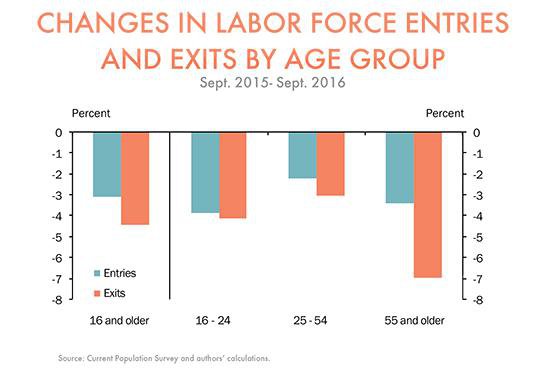More than 3 million people entered the labor force last year.
And it would appear as though new or previously discouraged workers are going to work. Appearances, however, can be misleading.
One of the driving forces behind the increase in the labor force participation rate is older workers remaining on the job. The reasons vary for their extended stay, but their presence is an important element in understanding current labor conditions.
Jonathan Willis and Didem Tüzemen, both economists with the Federal Reserve Bank of Kansas City, say changes in the labor force are driven by the combination of people entering and exiting the labor market. Entries consist of people who previously did not have a job and were not looking for work entering the labor force. Exits consist of people previously employed or actively looking for work leaving the labor force.
Willis and Tüzemen say the recent increase in labor force participation, from 62.4 percent in September 2015 to 62.9 percent in September 2016, could have occurred in one of two ways.
“First, the number of people entering the labor force could have accelerated faster than the number of people exiting the labor force,” the two economists explain in their recent research “What is Behind the Recent Increase in Labor Force Participation?”
In the second scenario, “the number of people exiting the labor force could have declined faster than the number of people entering it.”
In essence, people are working longer, and that’s what the economists think is driving the current labor participation rate increase.

The current workforce
The number of workers exiting the labor force increased rapidly as the Great Recession took hold. In 2007, Willis and Tüzemen say some workers who lost their jobs became discouraged and stopped looking for work, and some discouraged workers who were close to retirement chose to retire early. During the recovery, from 2009 to 2011, many workers began to reenter the labor force, including some discouraged workers who had stopped looking for a job.
During this time, however, exits from the labor force still outpaced entries, contributing to the continued decline in the labor force participation rate. This trend continued into 2014, although the labor force had begun to stabilize.
By 2015, however, entries and exits began to decline among workers in all age categories—16 and older—and the labor force participation rate began to increase most notably among older workers.
According to Willis and Tüzemen, from September 2015 to September 2016, the declines in entries and exits for workers 16 to 24 were similar to the overall average. For workers age 25 to 54, the decline in exits exceeded the decline in entries. This suggests that people were remaining in their jobs longer, they say.
More pronounced were the number of people staying in their jobs among workers age 55 and older. They experienced a decline of more than 7 percent in exits from the labor force, much less than other age groups.
Tüzemen and Willis say there are several reasons for the increase in the labor force participation rate such as increasing wages, a growing jobs market and better quality jobs. These reasons encourage people to keep looking for work, for workers with a job to stay employed for longer stretches of time, and for older workers to delay retirement decisions.
“In other words, the ‘revolving door’ of the labor force is slowing down as workers are matched to better, more stable jobs,” the economists explained.
Staying on the job
At age 66, Jim Kerr says it’s still great to receive a regular paycheck, but to him, working is more than just money.
“I love what I do,” he said.
Kerr became a pharmacist in the late 1970s, licensed both in Kansas and Missouri. He owned and operated his own pharmacy for 21 years in the Kansas City area until he sold it to local grocery store chain. He made a deal with the company to remain at the pharmacy, where he has been ever since.
“I have to say that helping people is one of the primary reasons for me,” he said.
Another reason he keeps working is a desire to pass on his knowledge and sense of community service to the younger generation of pharmacists. Besides his regular customers at the pharmacy, Kerr has worked with nonprofit clinics, medical organizations, church groups and community organizations such as Heart to Heart International, which provides global humanitarian assistance.
Kerr says there are obstacles for older workers to remain relevant in a changing work force, but he’s found ways to use those hindrances to remain in the labor force.
For instance, many older workers might see the rapid pace of technology in the workplace as a hindrance to extending their careers. And in some industries, technology has eliminated many jobs. Kerr says the rapidly changing technological advancements in the drug and healthcare industries have made his work less difficult in some aspects.
“Back when I had the pharmacy, I told myself I’d never get a computer, and three years later I bought one because medical records were going digital.”
Today, medical records, drug information and dosages, and other related information Kerr once had to keep track of on paper or by memory are only a few clicks away on a computer network.
“Technology advancements give me an opportunity to keep learning,” he said.
What if he runs into a technological barrier?
“I rely on the younger workers, whose generation is more tech savvy than me, to help me learn,” he said.
Besides remaining relevant, the cost of living more than likely keeps many older workers on the job, Kerr said.
“Health benefits are a big concern,” he said.
As a pharmacist, he knows what it’s like to work with Medicare and health insurance providers.
“There are a lot of costs involved,” he said.
He gave one example of a customer who pays $150 a month out of his pocket for one medication. Although that person can afford it, many retirees live on tight budgets, and any increase in medication or medical expenses can have negative effects on their quality of living.
“So when you’re faced with those kind of costs sometimes it makes more sense to keep working,” he said.

Further Resources
Read “What is Behind the Recent Increase in Labor Force Participation?” by Didem Tüzemen and Jonathan Willis
Read “Stuck in Part-Time Employment” by Jonathan Willis
COMMENTS/QUESTIONS are welcome and should be sent to teneditors@kc.frb.org.
